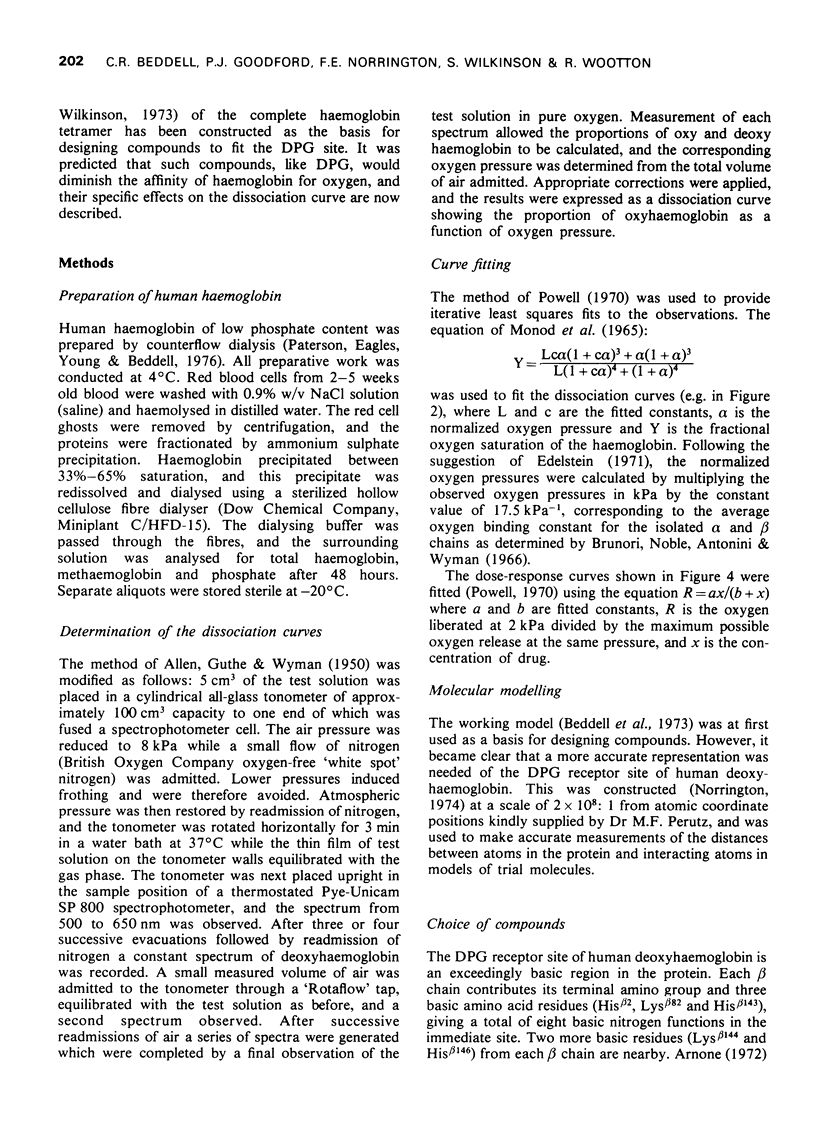Abstract
1 The three-dimensional coordinates of the atoms in human haemoglobin are known, and there is a specific site in the deoxygenated form of the protein at which 2,3-diphosphoglycerate (DPG) interacts. 2 Molecular models of this site have been constructed and used to design compounds which should bind to the deoxy conformation and stabilize it. These compounds should therby promote oxygen liberation, as does DPG. 3The compounds so designed were found to promote oxygen liberation. Their relative potencies, as assessed by sigmoidal dose-response curves, are in the predicted sequence.
Full text
PDF








Selected References
These references are in PubMed. This may not be the complete list of references from this article.
- ALLEN D. W., GUTHE K. F., WYMAN J., Jr Further studies on the oxygen equilibrium of hemoglobin. J Biol Chem. 1950 Nov;187(1):393–410. [PubMed] [Google Scholar]
- Arnone A. X-ray diffraction study of binding of 2,3-diphosphoglycerate to human deoxyhaemoglobin. Nature. 1972 May 19;237(5351):146–149. doi: 10.1038/237146a0. [DOI] [PubMed] [Google Scholar]
- Bedell C. R., Goodford P. J., Norrington F. E., Wilkinson S. A 'working' model of the haemoglobin molecule as a receptor for 2,3-diphosphoglycerate. Br J Pharmacol. 1973 Jun;48(2):363P–364P. [PMC free article] [PubMed] [Google Scholar]
- Belleau B. Stereochemistry of adrenergic receptors: newer concepts on the molecular mechanism of action of catecholamines and antiadrenergic drugs at the receptor level. Ann N Y Acad Sci. 1967 Feb 10;139(3):580–605. doi: 10.1111/j.1749-6632.1967.tb41231.x. [DOI] [PubMed] [Google Scholar]
- Benesch R., Benesch R. E. The effect of organic phosphates from the human erythrocyte on the allosteric properties of hemoglobin. Biochem Biophys Res Commun. 1967 Jan 23;26(2):162–167. doi: 10.1016/0006-291x(67)90228-8. [DOI] [PubMed] [Google Scholar]
- Brunori M., Noble R. W., Antonini E., Wyman J. The reactions of the isolated alpha and beta chains of human hemoglobin with oxygen and carbon monoxide. J Biol Chem. 1966 Nov 25;241(22):5238–5243. [PubMed] [Google Scholar]
- Chanutin A., Curnish R. R. Effect of organic and inorganic phosphates on the oxygen equilibrium of human erythrocytes. Arch Biochem Biophys. 1967 Jul;121(1):96–102. doi: 10.1016/0003-9861(67)90013-6. [DOI] [PubMed] [Google Scholar]
- Edelstein S. J. Extensions of the allosteric model for haemoglobin. Nature. 1971 Mar 26;230(5291):224–227. doi: 10.1038/230224a0. [DOI] [PubMed] [Google Scholar]
- Eldefrawi M. E., Eldefrawi A. T. Purification and molecular properties of the acetylcholine receptor from Torpedo electroplax. Arch Biochem Biophys. 1973 Nov;159(1):362–373. doi: 10.1016/0003-9861(73)90462-1. [DOI] [PubMed] [Google Scholar]
- Good N. E., Winget G. D., Winter W., Connolly T. N., Izawa S., Singh R. M. Hydrogen ion buffers for biological research. Biochemistry. 1966 Feb;5(2):467–477. doi: 10.1021/bi00866a011. [DOI] [PubMed] [Google Scholar]
- KENDREW J. C., WATSON H. C., STRANDBERG B. E., DICKERSON R. E., PHILLIPS D. C., SHORE V. C. The amino-acid sequence x-ray methods, and its correlation with chemical data. Nature. 1961 May 20;190:666–670. doi: 10.1038/190666a0. [DOI] [PubMed] [Google Scholar]
- Langley J. N. On the Physiology of the Salivary Secretion: Part II. On the Mutual Antagonism of Atropin and Pilocarpin, having especial reference to their relations in the Sub-maxillary Gland of the Cat. J Physiol. 1878 Sep 25;1(4-5):339–369. doi: 10.1113/jphysiol.1878.sp000028. [DOI] [PMC free article] [PubMed] [Google Scholar]
- MONOD J., WYMAN J., CHANGEUX J. P. ON THE NATURE OF ALLOSTERIC TRANSITIONS: A PLAUSIBLE MODEL. J Mol Biol. 1965 May;12:88–118. doi: 10.1016/s0022-2836(65)80285-6. [DOI] [PubMed] [Google Scholar]
- Perutz M. F., Miurhead H., Cox J. M., Goaman L. C., Mathews F. S., McGandy E. L., Webb L. E. Three-dimensional Fourier synthesis of horse oxyhaemoglobin at 2.8 A resolution: (1) x-ray analysis. Nature. 1968 Jul 6;219(5149):29–32. doi: 10.1038/219029a0. [DOI] [PubMed] [Google Scholar]
- SUGITA Y., CHANUTIN A. Electrophoretic studies of red cell hemolysates supplemented with phosphorylated carbohydrate intermediates. Proc Soc Exp Biol Med. 1963 Jan;112:72–75. doi: 10.3181/00379727-112-27953. [DOI] [PubMed] [Google Scholar]
- SUTHERLAND E. W., POSTERNAK T., CORI C. F. Mechanism of the phosphoglyceric mutase reaction. J Biol Chem. 1949 Nov;181(1):153–159. [PubMed] [Google Scholar]
- Smythies J. R. The molecular structure of acetycholine and adrenergic receptors: an all-protein model. Int Rev Neurobiol. 1975;17:131–187. doi: 10.1016/s0074-7742(08)60209-3. [DOI] [PubMed] [Google Scholar]
- Stein W. D., Lieb W. R., Karlish S. J., Eilam Y. A modle for active transport of sodium and potassium ions as mediated by a tetrameric enzyme. Proc Natl Acad Sci U S A. 1973 Jan;70(1):275–278. doi: 10.1073/pnas.70.1.275. [DOI] [PMC free article] [PubMed] [Google Scholar]


